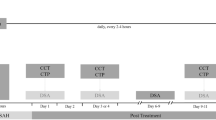Abstract
Introduction
Presenting symptoms of aneurysmal subarachnoid hemorrhage (SAH) and reversible cerebral vasoconstriction syndrome (RCVS) may overlap. Patients with RCVS often harbor unruptured aneurysms.
Summary of Case
We report a case of RCVS in a patient with an unruptured intracranial aneurysm. The development of diffuse vasoconstriction after aneursym clipping in the absence of any subarachnoid blood was initially confusing, until subtle vasoconstriction before clipping was seen retrospectively.
Results
We obtained perfusion and diffusion MRI studies on this patient, which shed light on the pathophysiology of RCVS.
Conclusion
It is important for physicians who care for patients with aneurysmal SAH to recognize RCVS, as the treatments for these two conditions are different.






Similar content being viewed by others
References
Singhal AB, Bernstein RA. Postpartum angiopathy and other cerebral vasoconstriction syndromes. Neurocrit Care 2005;3(1):91–7.
Bernstein RA. Reversible cerebral vasoconstriction syndromes. Curr Treat Options Cardiovasc Med 2006;8:229–34.
Call GK, Fleming MC, Sealfon S, Levine H, Kistler JP, Fisher CM. Reversible cerebral segmental vasoconstriction. Stroke 1988;19(9):1159–70.
Ringer AJ, Qureshi AI, Kim SH, Fessler RD, Guterman LR, Hopkins LN. Angioplasty for cerebral vasospasm from eclampsia. Surg Neurol 2001;56(6):373–8, (discussion 378–9).
Singhal AB, Caviness VS, Begleiter AF, Mark EJ, Rordorf G, Koroshetz WJ. Cerebral vasoconstriction and stroke after use of serotonergic drugs.[see comment]. Neurology 2002;58(1):130–3.
Singhal AB. Postpartum angiopathy with reversible posterior leukoencephalopathy. Arch Neurol 2004;61(3):411–6.
Day JW, Raskin NH. Thunderclap headache: symptom of unruptured cerebral aneurysm. Lancet 1986;2(8518):1247–8.
Singhal AB. Thunderclap headache, reversible cerebral arterial vasoconstriction, and unruptured aneurysms.[comment]. J Neurol Neurosurg Psychiatry 2002;73(1):96, (author reply 96–7).
Calabrese LH. Vasculitis of the central nervous system. Rheum Dis Clin North Am 1995;21(4):1059–76.
Caplan LR, Hennerici M. Impaired clearance of emboli (washout) is an important link between hypoperfusion, embolism, and ischemic stroke. Arch Neurol 1998;55(11):1475–82.
Author information
Authors and Affiliations
Corresponding author
Rights and permissions
About this article
Cite this article
Nickele, C., Muro, K., Getch, C.C. et al. Severe reversible cerebral vasoconstriction syndrome mimicking aneurysmal rupture and vasospasm. Neurocrit Care 7, 81–85 (2007). https://doi.org/10.1007/s12028-007-0001-4
Published:
Issue Date:
DOI: https://doi.org/10.1007/s12028-007-0001-4




